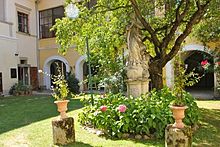St. Georgen Castle on the Stiefing
| Sankt Georgen Castle on the Stiefing | ||
|---|---|---|
|
West view |
||
| Creation time : | 12th century | |
| Place: | Sankt Georgen an der Stiefing (Leibnitz district / Styria) | |
| Geographical location | 46 ° 52 '34.9 " N , 15 ° 34' 43" E | |
|
|
||
The castle of St. Georgen is located in the same place Sankt Georgen an der Stiefing in the district of Leibnitz in the Austrian province of Styria . The castle represents a structural unit established in history with the parish church of St. Georgen an der Stiefing (original castle church).
history
12th to 15th centuries
Until the 12th century
The researched settlement history of the area around St. Georgen Castle (see History of Wildon ) goes back to the Neolithic Age (4000 BC).
The castle was first mentioned in 1147 when Rupertus von St. Georgen (Rupertus de sancte Georgia) donated vineyards on the nearby Aframberg to Admont Abbey .
Count Luitold I of Plain (1122–1164) from the noble family of the powerful Counts of Plain is to be regarded as the founder of the castle and church of St. Georgen. The exact form and construction of the original building has not been researched. Today there are still remains of a portal in the crypt of the church, which has a Romanesque architectural style and could therefore come from the time it was founded, or at least from an early era of the building complex.
13th Century
After the Counts of Plain died out in 1253, their possessions, including St. Georgen Castle, were transferred to the Bishop of Seckau and his successors. At that time, St. Georgen consisted of six large farmsteads, 20 smaller farms and a few tradespeople.
15th century
In 1480 the St. Georgen Castle was occupied by the troops of the Hungarian King Matthias Corvinus and in 1481 by the troops of Emperor Friedrich III. recaptured. The castle, the church and the place were devastated in the course of these acts of war.
16th to 18th century
16th Century
In 1532 Turkish armies under Suleiman II crossed the Styrian border and devastated St. Georgen and the surrounding area. On September 10th, 1555, Bishop Peter von Seckau sold the castle and associated goods to the noble Andre von Glojach from the ancient Styrian family of the von Glojach (noble family) . Andre von Glojach carried out major renovation and expansion work on St. Georgen Castle in the following years. The renaissance architecture that defines the castle today, as well as the stone outside staircase in the castle courtyard, originate from this renovation phase.
The castle remained in the possession of the Glojach family until 1754 .
18th century
In 1754 Joseph Egkh von Hungerspach and his wife Maria Anna bought St. Georgen Castle. The coat of arms on the main portal of St. Georgen Castle still reminds of these castle owners. The knight's hall was redesigned in the neo-baroque style by the new owners as early as 1755 . Furthermore, the statues of Maria Immaculata in the courtyard and of Johannes Nepomuk as well as the angel on St. John's Hill in front of the castle date from this period (1769) in the workshop of the sculptor Veit Königer .
19th to 20th century
19th century
In 1816 the former bailiff of Tannhausen, Franz Xaver Mihurko, took over the rule of the castle in a time of crisis due to the French wars. In 1823, Count Anton von Attems followed as lord of the castle. In 1859 Karl Binder von Kriegelstein acquired St. Georgen Castle. In 1876 the oldest wing of the castle was torn down due to disrepair, creating the so-called bastion garden.
20th century
In 1917 the castle was sold to Hans Graf Fink von Finkenstein, Elena Longinotto lived and managed the castle for several years. In 1925 Paul Ernst , a well-known writer, poet and thinker, bought the castle. In 1933 he found his final resting place on St. John's Hill in front of the castle. Else Ernst , the poet's wife, lived for a few more years at St. Georgen Castle and was also buried on the Johannishügel in 1946. After that, the castle was lived in and managed by Barbara Ernst, daughter-in-law of the poet couple Paul and Else Ernst. Karl Schmelzer-Ziringer bought the castle in 1975 from the heirs of the Ernst couple. He planned to build a music school, but it did not materialize.
The presence
In 1981, the married couple Dr. Franz and Christine Reinisch the St. Georgen Castle. In the following years the castle was renovated and adapted as a residence. From 1992 the castle was partially used and from 2011 entirely in the service of the massage school founded by the Reinisch couple and run by their descendants.
Surroundings
Neighboring castles are Herbersdorf Castle and Neudorf Castle near Wildon, Frauheim Castle, Laubegg Castle and Rohr Castle .
literature
- Robert Baravalle: Castles and Palaces of Styria , Stiasny Verlag 1961
- Local history 800 years of the parish of St. Georgen




